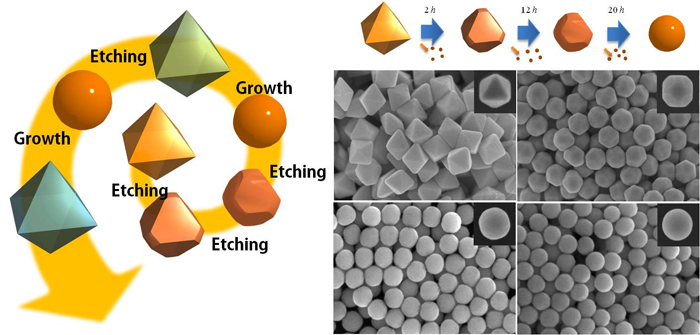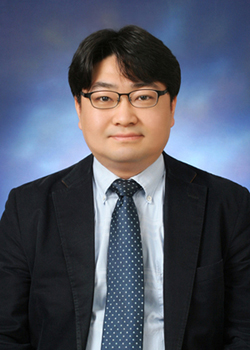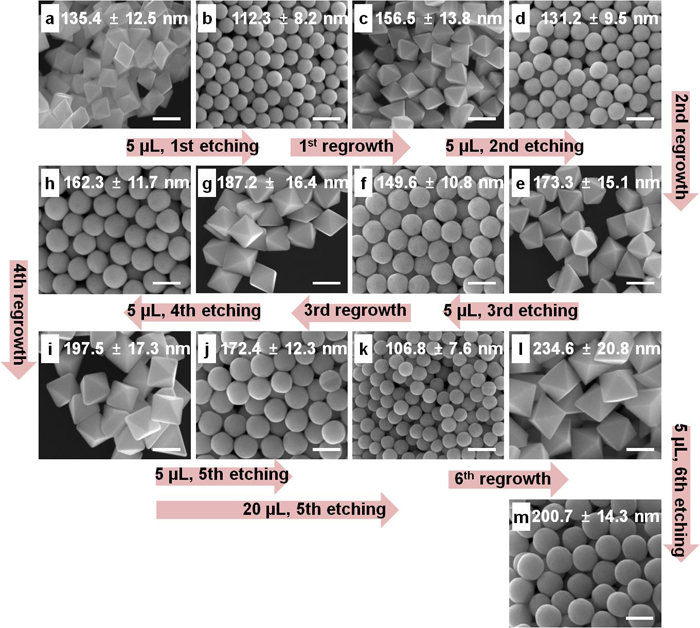-
 Korea.net's 24-hour YouTube channel
Korea.net's 24-hour YouTube channel- NEWS FOCUS
- ABOUT KOREA
- EVENTS
- RESOURCES
- GOVERNMENT
- ABOUT US
A joint Korea-U.S. research team has developed “ultra-smooth, highly spherical monocrystalline gold nanospheres” for the first time ever in the history of nanotechnology.

 The gold particles, when reduced to a nanometer-sized scale, take on unique characteristics and can be used across a range of applications, for example, photoelectrons, electronic devices, bio-elements and sensors. Such gold nanospheres have, so far, been produced with a variety of different shapes, including octahedrons (eight faces), decahedrons (ten faces), cubes (four faces) and rods, but for the first time now, spherical gold particles have been made on the order of 100 nm and larger.
The gold particles, when reduced to a nanometer-sized scale, take on unique characteristics and can be used across a range of applications, for example, photoelectrons, electronic devices, bio-elements and sensors. Such gold nanospheres have, so far, been produced with a variety of different shapes, including octahedrons (eight faces), decahedrons (ten faces), cubes (four faces) and rods, but for the first time now, spherical gold particles have been made on the order of 100 nm and larger.
The Korean team is led by Professor Yi Gi-ra of the School of Chemical Engineering at Sungkyunkwan University and by Professor Lee Gae-hang from the Korea Basic Science Institute. They launched their joint research team with Professor Federico Capasso of Harvard University in December last year.
In the course of their research, they found that spherical gold nanoparticles can be produced through a cyclical process of slow growth followed by slow chemical etching, which selectively removes the edges and vertices.
Many academics see this development as a breakthrough in that such completely round gold nanocrystals can be critical in the use of DNA sensors, photonic crystal particles or high-sensitivity sensors.

“The development of spherical nanoparticles will help us pursue further research into the optical properties that gold nanocrystals hold,” said Professor Yi Gi-ra. “On top of that, this will become an important base for future applied studies, such as the development of sensing elements for medical purposes.”
By Sohn JiAe
Korea.net Staff Writer
jiae5853@korea.kr

The image shows the cyclical process of slow growth and etching required to make gold octahedral nanospheres, which then slowly turn into ultra-smooth, highly spherical nanocrystals. (Photo courtesy of the Ministry of Science, ICT and Future Planning)

Professor Yi Gi-ra of the School of Chemical Engineering at Sungkyunkwan University is taking part in the joint research project. (Photo Courtesy of the Ministry of Science, ICT and Future Planning)
The Korean team is led by Professor Yi Gi-ra of the School of Chemical Engineering at Sungkyunkwan University and by Professor Lee Gae-hang from the Korea Basic Science Institute. They launched their joint research team with Professor Federico Capasso of Harvard University in December last year.
In the course of their research, they found that spherical gold nanoparticles can be produced through a cyclical process of slow growth followed by slow chemical etching, which selectively removes the edges and vertices.
Many academics see this development as a breakthrough in that such completely round gold nanocrystals can be critical in the use of DNA sensors, photonic crystal particles or high-sensitivity sensors.

These scanning electron microscope (SEM) images show the gold nanocrystals after the repeated growth-and-etching process. (Photo courtesy of the Ministry of Science, ICT and Future Planning)
“The development of spherical nanoparticles will help us pursue further research into the optical properties that gold nanocrystals hold,” said Professor Yi Gi-ra. “On top of that, this will become an important base for future applied studies, such as the development of sensing elements for medical purposes.”
By Sohn JiAe
Korea.net Staff Writer
jiae5853@korea.kr
Most popular
- First hearing-impaired K-pop act hopes for 'barrier-free world'
- 'Mad Max' director impressed by 'cinema-literate' Korean viewers
- Romanian presidential couple visits national cemetery
- President, Romania pledge better defense, nuclear power ties
- President Yoon, Japan PM pledge better trilateral ties with US














